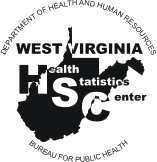Chronic Lower Respiratory Disease
A state and national problem
Executive Summary
General Facts
Chronic Lower Respiratory Disease (CLRD) is the fourth leading cause of death in the United States but
the third leading cause of death in West Virginia. It is projected to be third nationwide by 2020.
CLRD comprises three major diseases: chronic bronchitis, emphysema, and asthma.
Approximately $42.7 billion is spent annually on direct and indirect health care costs due to CLRD.
Tobacco smoking is the most important risk factor for chronic bronchitis and emphysema, accounting
for about 80% of cases. Cigarette smokers are 10 times more likely to die from these diseases than
nonsmokers. The remaining 20% of cases are attributable to environmental exposures and genetic factors.
Asthma appears to have a strong genetic basis, with 30% to 50% of all cases due to an inherited predisposition.
A direct association between secondhand smoke and lower respiratory disease has been documented
by the Environmental Protection Agency.
Smoking cessation in the single most effective way to reduce the risk of CLRD and its progression.
Approximately 124,000 people die each year in the United States from CLRD. This estimate is considered
low, however, because CLRD is often cited as a contributory, not underlying, cause of death on the death
certificate.
Lower respiratory disease deaths increased in the United States by 163% between 1965 and 1998.
This trend reflects smoking patterns initiated 30 to 50 years ago.
West Virginia Statistics
Prevalence
According to the American Lung Association, in 2002 there were approximately 64,000 people with
chronic bronchitis and 22,450 people with emphysema in the state.
According to 2001 Behavioral Risk Factor Surveillance System data, 12% of adult West Virginians
have received a diagnosis of asthma, compared with a national rate of 11%. Data from the Youth
Tobacco Survey (YTS) show that 23% of middle school students and 21% of high school students have
received an asthma diagnosis at some time in their lives.
Smoking
In 2001, 28% of adult residents reported being current smokers, the 4th highest rate in the country.
Nearly 25% reported being former smokers. This means that over one-half (53%) of all adults in West
Virginia have put or are currently putting themselves at risk for CLRD.
Sixteen percent (16%) of middle school students reported on the YTS that they currently smoke, i.e.,
have smoked cigarettes on one or more of the past 30 days. More than one in three (34%) high school
students report current smoking.
Seventy-three percent (73%) of middle school students and 83% of high school students report exposure
to secondhand smoke.
Hospitalizations
Using hospital discharge data, it was found that the rates of hospitalization for chronic bronchitis
in West Virginia in 2000 were three times higher than rates nationwide. The rate of asthma hospitalization
was somewhat lower in the state than in the nation as a whole.
The rates of hospitalization for chronic bronchitis and emphysema have increased steadily since 1996
among both men and women.
Total charges for COPD hospitalizations in 2000 amounted to $67,821,146, an increase of 32% from 1996.
Medicare bears the brunt of CLRD costs (71%).
Mortality
West Virginia’s rate of CLRD mortality of 63.2 deaths per 100,000 population was the highest in the
country in 2000. The state rate exceeds the national rate for both sexes and all age groups.
West Virginia’s rate of CLRD as a contributing cause of death in 2000 was also higher than the
national rate for both sexes and all age groups.
Top of Page
|

